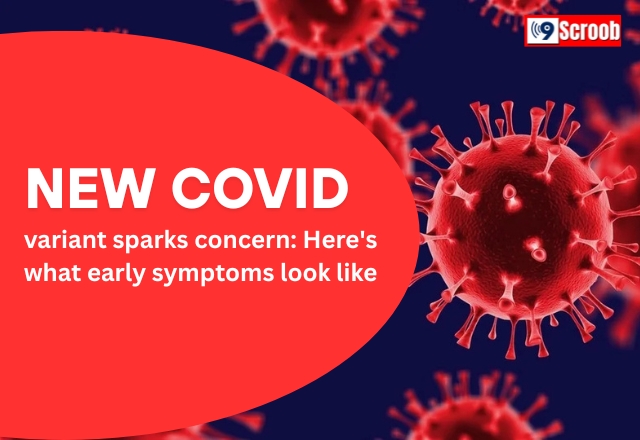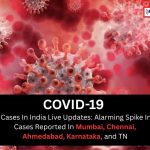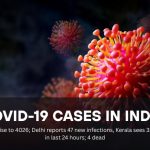New COVID Variant NB.1.8.1: What You Need to Know About Symptoms, Spread, and Prevention
New COVID Variant Detected: A newly emerging COVID-19 variant, NB.1.8.1, is raising global concern due to its increasing presence across multiple countries. While there’s no evidence that it causes more severe illness than previous strains, its ability to bind more efficiently to human cells suggests it could spread more easily.
How the NB.1.8.1 Variant Is Spreading
Recent reports indicate that the variant has started to spread locally in some areas, suggesting community transmission is underway. In parts of Asia, NB.1.8.1 has been linked to a noticeable rise in COVID-19 cases.
In China, for example, the percentage of severely ill respiratory patients testing positive for COVID-19 increased from 3.3% to 6.3% in the past month. Additionally, COVID-19 positivity among emergency room patients in Chinese hospitals rose dramatically from 7.5% to 16.2%. Taiwan also reported a 78% surge in hospital admissions related to the virus.
In Hong Kong, hospitalizations due to COVID-19 have reached their highest levels in a year. As a precaution, local authorities are once again encouraging residents to wear face masks in public transport and crowded areas.
Although the World Health Organization (WHO) confirms the variant’s potential for higher transmissibility, they currently see no evidence suggesting NB.1.8.1 leads to more severe illness or better immune evasion than existing strains.
How Did the Variant Reach the United States?
The new variant has made its way to the U.S. primarily through international travelers. Most of the identified cases originated from individuals arriving from China, Japan, Vietnam, South Korea, Taiwan, Thailand, France, the Netherlands, and Spain.
Testing was conducted on voluntary nasal swabs collected between April 22 and May 12 at several major airports. In addition to international travelers, health officials have confirmed local cases in Ohio, Rhode Island, Hawaii, California, and Washington, with some dating back to late March and early April.
Despite these findings, the U.S. has not seen a corresponding spike in COVID-19 cases. In fact, recent data shows a 12% decrease in test positivity rates, suggesting that widespread community transmission has not yet occurred.
Early Symptoms of NB.1.8.1: What to Watch For
The NB.1.8.1 variant appears to cause a slightly different symptom profile compared to earlier strains. Here are the most commonly reported early symptoms:
1. Persistent Low-Grade Hyperthermia
Instead of a high fever, many individuals report a mild but prolonged increase in body temperature (between 37.6°C and 38.1°C). This low-grade fever often lacks typical symptoms like sweating or rapid breathing and may point to changes in the body’s thermoregulation.
2. Upper Respiratory Symptoms
As seen with other Omicron subvariants, NB.1.8.1 frequently causes sore throat, cough, nasal congestion, and mild fever.
3. Gastrointestinal Issues
Some patients have experienced nausea, reduced appetite, and general stomach discomfort.
4. Neurological Symptoms
Reports include headaches, lightheadedness, and difficulty concentrating, sometimes referred to as “brain fog.”
5. Fatigue and Muscle Weakness
A notable symptom among those infected is extreme tiredness, making daily tasks difficult for many.
6. Sleep Disruption and Anxiety
Similar to closely related variants like JN.1, some individuals have reported anxiety, restlessness, and trouble sleeping.
Preventive Measures to Protect Yourself and Others
With the potential for the NB.1.8.1 variant to spread internationally, particularly through air travel, it’s important to take appropriate precautions. Health experts recommend the following:
- Stay Vaccinated: Make sure your COVID-19 vaccinations and boosters are current to reduce the risk of severe illness.
- Wear Masks in Crowded Places: Using face masks on public transport or in enclosed, busy settings can help reduce exposure.
- Practice Good Hygiene: Regular handwashing with soap or the use of alcohol-based hand sanitizers can minimize the risk of transmission.
- Monitor for Symptoms: Stay alert for any of the symptoms listed above and seek medical advice if they appear.
- Isolate When Sick: If you develop symptoms, isolate yourself to prevent spreading the virus to others.
Final Thoughts
While the NB.1.8.1 variant does not currently appear to cause more severe illness, its rapid spread highlights the need for continued caution and preventive action. Staying informed, monitoring symptoms, and following public health recommendations remain the best ways to protect yourself and your community.














